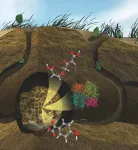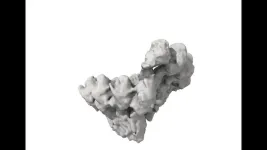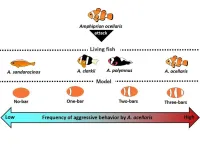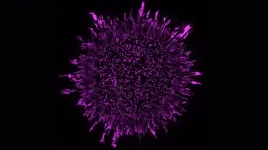(Press-News.org) For centuries, doctors have used their hands as essential diagnostic tools — exploring joints and palpating abdomens to assess a patient’s health. Often a cancer will reveal itself as a lump or unusual stiffness in a normally bouncy tissue or organ.
More recently, the relationship between stiffness and cancer has been documented through biophysical studies and clinical trials, particularly in liver and breast cancer. For example, stiffness is a primary hallmark of liver cirrhosis, which can progress to liver cancer.
Now researchers at Stanford University have shown that another biophysical characteristic known as viscoelasticity — think of how stretching a ball of Silly Putty or a clump of bread dough is met at first with resistance, and then with release — is even more tightly correlated with liver cancer than stiffness, particularly in people with Type 2 diabetes.
The distinction matters because people with Type 2 diabetes are two to three times as likely as people without diabetes to develop liver cancer, which often occurs in the absence of cirrhosis. Liver cancer rates are increasing in part because the prevalence of diabetes is growing worldwide, particularly in marginalized communities where healthy food choices and opportunities for regular exercise are scarce.
“This is the first time that the dogma of matrix stiffness as a primary predictor of liver cancer is being challenged,” said professor of gastroenterology and hepatology Natalie Torok, MD. “Current guidelines recommend routine liver cancer screening only for people with cirrhosis. As a result, many people with Type 2 diabetes are not screened at all. These new findings have major implications not just for liver cancer, but also other cancers for which diabetes is a risk factor, including breast cancers.”
Torok is the senior author of the study, which was published online Jan. 31 in Nature. Postdoctoral scholar Weiguo Fan, PhD, is the lead author.
Torok and her colleagues collaborated with researchers in the laboratory of associate professor of mechanical engineering Ovijit Chaudhuri, PhD, to investigate the role of viscoelasticity in liver cancer in patient samples, animal models and cells grown in the laboratory in a Jell-O-like tissue scaffolding called a hydrogel.
“This study is the first on the role of viscoelasticity in cancer with data that spans from humans and mouse models to in vitro 3D culture studies and computational simulations,” Chaudhuri said. “It definitively establishes the role of viscoelasticity in liver cancer progression.”
The study was supported by Stanford Medicine’s SPARK Program in Translational Research and its Innovative Medicines Accelerator, complementary programs meant to streamline the path of promising academic laboratory discoveries to clinical applications that benefit patients.
Stiffness test
Liver stiffness is measured non-invasively with imaging techniques called transient elastography or MR elastography involving a vibrating pad placed on the abdomen. The vibrations are transmitted from the imaging probe to the organ; the wave of vibration moving through a stiff medium differs from one moving through something more malleable. People with a liver stiffness that exceeds a certain threshold are diagnosed with liver cirrhosis; current guidelines recommend that they be screened every six months for liver cancer with an abdominal ultrasound and blood tests.
Measurements such as stiffness arise from what’s called the extracellular matrix — the space between and around an organ’s cells that is chock-a-block with proteins, sugars and minerals.
“Our organs are not just clumps of cells,” Chaudhuri said. “The cells exist in a scaffolding called the extracellular matrix that gives them physical support but also affects their maturation, specialization and functioning.”
Like a grade-school teacher, the matrix provides a physical framework that supports and organizes the cells, gentling and channeling them to harmoniously create a functional tissue. When the matrix is disrupted, any bad-apple cancerous or pre-cancerous cells more readily lose their way, spreading to places they shouldn’t; dividing uncontrollably; or morphing in to other, more dangerous versions of themselves.
People with diabetes have elevated levels of what are called advanced glycation end products, or AGEs. AGEs arise when blood sugar is poorly controlled and elevated levels of sugar molecules known as glucose begin to glom onto nearby proteins including collagen — a key structural component of the extracellular matrix. (AGEs are also present in protein- or fat-rich foods or in foods prepared at high heat such as frying or broiling.)
The researchers found that liver samples from people with Type 2 diabetes had higher levels of AGEs and were more viscoelastic — but no more stiff — than liver samples from people without Type 2 diabetes. A closer look in laboratory mice showed animals fed a diet high in AGEs had shorter and less interconnected collagen fibers in the liver’s extracellular matrix than those found in animals fed standard chow.
Next, the researchers studied how cells behaved when grown in the laboratory in a three-dimensional gel to mimic liver matrix structure. Tinkering with the cells outside the body allowed them to assess the effect of various changes in their growth and behavior.
“In our engineered hydrogels, we can tune one biophysical property such as viscoelasticity or stiffness at a time to understand how each property impacts the cells,” Chaudhuri said. “We saw that a change in viscoelasticity alone is enough to drive a more invasive behavior in the cells.”
In particular, the researchers noted that a more viscoelastic matrix promotes changes in liver cell shape and allows the formation of invasive protrusions on their membranes that help them escape natural barriers meant to keep cells in their rightful places.
Paradigm shift
Finally, Torok and her colleagues went one step further, dissecting a series of cellular signals that promote liver cancer progression in viscoelastic conditions that includes a cancer-associated protein called YAP.
“This is the first time that changes in collagen structure have been proven to promote viscoelasticity and liver cancer progression independent of stiffness,” Torok said. “It’s a complete change in paradigm that could explain the greater risk of liver cancer in people with Type 2 diabetes and may help select people should undergo regular liver cancer screening.”
Fortunately, like stiffness, viscoelasticity can be assessed non-invasively with MR elastography by changing a few parameters in vibration frequency and measurement. Torok is planning to launch a clinical trial to further study viscoelasticity, Type 2 diabetes and liver cancer progression.
“One of the major questions in medicine today is why people with diabetes and fatty liver disease are so prone to liver cancer, and how we can address this,” Torok said. “Our research suggests that many more people, particularly those with diabetes, should be screened for cancer. If we did that, perhaps we could act earlier and save lives.”
Researchers from Purdue University; Tsinghua University in Beijing; the University of Pittsburgh; the University of California, Davis; Albert Einstein College of Medicine; Keio University in Yokohama; and the University of Pennsylvania contributed to the work.
The study was funded by the National Institutes of Health (grants R01DK083283, RO1CA277710, 1RO1AG060726, R37 CA214136, 1R01CA251155, 1R01CA204586 and 1R01GM126256) and a Stanford SPARK award.
END
Diabetes and liver cancer — Stanford Medicine study suggests new screening guidelines
A Stanford Medicine study identifies an easily measured biophysical property that can identify Type 2 diabetics at increased risk for liver cancer who don’t meet current screening guidelines.
2024-02-01
ELSE PRESS RELEASES FROM THIS DATE:
Researchers take new ‘mixed reality’ headsets for a spin
2024-02-01
Among the buzziest consumer technologies right now are “mixed reality” or “spatial computing” headsets that convincingly blend views of the real world with digital content.
A key enabling technology behind these gizmos is passthrough video, which involves blocking out all light so users must rely on cameras on the headsets to see the external world around them via real-time video playing on tiny screens. The arrangement allows users to physically interact with their environments and go about daily activities but with added digital content displayed, ranging from familiar device apps to innovative gaming scenarios. ...
How leafcutter ants cultivate a fungal garden to degrade plants and provide insights into future biofuels
2024-02-01
By Maegan Murray
Scientists have spent decades finding ways to efficiently and affordably degrade plant materials so that they can be converted into useful bioproducts that benefit everyday life.
Bio-based fuels, detergents, nutritional supplements, and even plastics are the result of this work. And while scientists have found ways to degrade plants to the extent needed to produce a range of products, certain polymers such as lignin, which is a primary ingredient in the cell wall of plants, remain incredibly difficult to affordably break down without adding pollutants back into the environment. These polymers can be left behind as waste products with ...
UC Davis establishes bird flight research center
2024-02-01
Researching how bird flight can inform aircraft design is the goal of a new center to be established at the University of California, Davis.
Christina Harvey, an assistant professor of mechanical and aerospace engineering at UC Davis, and Michelle Hawkins, a professor in the School of Veterinary Medicine and director of the California Raptor Center, are launching the bird flight research center with a nearly $3 million grant from the Department of Defense. The new center will utilize motion capture and photogrammetry ...
ADA releases updated recommendations to enhance radiography safety in dentistry
2024-02-01
CHICAGO, Feb. 1, 2024 – The use of lead abdominal aprons or thyroid collars on patients when conducting dental X-rays is no longer recommended, according to an expert panel established by the American Dental Association (ADA) Council on Scientific Affairs. Additionally, dentists should take into consideration the diagnostic information needed from X-rays to benefit patient care or substantially improve clinical outcomes.
The Journal of the American Dental Association published the new recommendations today, which aim to improve radiation ...
Cheating death: How cancer cells escape
2024-02-01
Cell death is fundamental to life and, thus, healthy aging. In the realm of cellular biology, ferroptosis (a form of programmed cell death) has emerged not only as a focal point of research for its potential in eliminating cancer cells, but also its role in a plethora of other diseases, including neurodegenerative diseases such as Alzheimer’s disease, eye diseases such as Retinitis pigmentosa and age-related macular degeneration, as well as ischemia, cardiovascular disease, liver disease, acute kidney injury and inflammation.
While studies of other forms of cell death such as apoptosis focus largely on ...
JMIR Medical Informatics invites submissions on AI language models in health care
2024-02-01
JMIR Publications is pleased to announce a new section titled, “AI Language Models in Health Care” in JMIR Medical Informatics. This leading peer-reviewed journal is indexed in PubMed and has a unique focus on clinical informatics and the digitization of care processes. This section will have a broad focus and encompass topics about the successful implementation of artificial intelligence (AI) language models in diverse health care settings. The topics will include details about the process, use, outcomes, and ...
Human cells building ‘molecular highways’ captured for first time
2024-02-01
Researchers at the Centre for Genomic Regulation (CRG) in Barcelona and the Spanish National Cancer Research Centre (CNIO) in Madrid have captured the world’s first high-resolution images of the earliest moments of microtubule formation inside human cells. The findings, published today in the journal Science, lay the foundations for potential breakthroughs in treating many different types of diseases ranging from cancer to neurodevelopmental disorders.
“Microtubules are critical components of cells, but all the images we see in textbooks describing the first moments of their creation are models or cartoons based ...
Clown anemonefish seem to be counting bars and laying down the law
2024-02-01
We often think of fish as carefree swimmers in the ocean, reacting to the world around them without much forethought. However, new research from the Okinawa Institute of Science and Technology (OIST) suggests that our marine cousins may be more cognizant than we credit them for.
By observing how a colony of clown anemonefish (Amphiprion ocellaris) – the species of the titular character in Finding Nemo – reacts to intruders in their sea anemone home, OIST researchers have found that ...
New research shows that the arrangement of bacteria in biofilms affects their sensitivity to antibiotics
2024-02-01
Bacteria are traditionally imagined as single-cell organisms, spread out sparsely over surfaces or suspended in liquids, but in many environments the true bacterial mode of growth is in sticky clusters called biofilms. Biofilm formation can be useful to humans—it is integral, for example, to the production of kombucha tea. But it is more often problematic, because it makes it more difficult to control bacterial growth: When bacterial cells produce a biofilm, it acts as a shield against outside invaders, making the bacteria more ...
First atomic-scale 'movie' of microtubules under construction, a key process for cell division
2024-02-01
· Researchers at the Centre for Genomic Regulation (CRG) , the Spanish National Cancer Research Center (CNIO) and the IBMB-CSIC solve a key problem in biology: how human cells build their microtubules
· During cell division, microtubules function as nanometer-thick long ‘ropes' inside cells that pull chromosomes apart so that each daughter cell receives a copy of the genetic material
· The work published in Science lays the groundwork for future breakthroughs in the treatment of diseases ranging from cancer to neurodevelopmental disorders
Cells in the human body are constantly dividing. With each division the genetic information contained in the ...
LAST 30 PRESS RELEASES:
Scientists boost cell "powerhouses" to burn more calories
Automatic label checking: The missing step in making reliable medical AI
Low daily alcohol intake linked to 50% heightened mouth cancer risk in India
American Meteorological Society announces Rick Spinrad as 2026 President-Elect
Biomass-based carbon capture spotlighted in newly released global climate webinar recording
Illuminating invisible nano pollutants: advanced bioimaging tracks the full journey of emerging nanoscale contaminants in living systems
How does age affect recovery from spinal cord injury?
Novel AI tool offers prognosis for patients with head and neck cancer
Fathers’ microplastic exposure tied to their children’s metabolic problems
Research validates laboratory model for studying high-grade serous ovarian cancer
SIR 2026 delivers transformative breakthroughs in minimally invasive medicine to improve patient care
Stem Cell Reports most downloaded papers of 2025 highlight the breadth and impact of stem cell research
Oxford-led study estimates NHS spends around 3% of its primary and secondary care budget on the health impacts of heat and cold in England
A researcher’s long quest leads to a smart composite breakthrough
Urban wild bees act as “microbial sensors” of city health.
New study finds where you live affects recovery after a hip fracture
Forecasting the impact of fully automated vehicle adoption on US road traffic injuries
Alcohol-related hospitalizations from 2016 to 2022
Semaglutide and hospitalizations in patients with obesity and established cardiovascular disease
Researchers ‘listen in’ to embryo-mother interactions during implantation using a culture system replicating the womb lining
How changing your diet could help save the world
How to make AI truly scalable and reliable for real-time traffic assignment?
Beyond fragmented markets: A new framework for efficient and stable ride-pooling
Can shape priors make road perception more reliable for autonomous driving?
AI tracks nearly 100 years of aging research, revealing key trends and gaps
Innovative techniques enable Italy’s first imaging of individual trapped atoms
KIER successfully develops Korea-made “calibration thermoelectric module” for measuring thermoelectric device performance
Diversifying US Midwest farming for stability and resilience
Emphasizing immigrants’ deservingness shifts attitudes
Japanese eels, climate change, and river temperature
[Press-News.org] Diabetes and liver cancer — Stanford Medicine study suggests new screening guidelinesA Stanford Medicine study identifies an easily measured biophysical property that can identify Type 2 diabetics at increased risk for liver cancer who don’t meet current screening guidelines.





